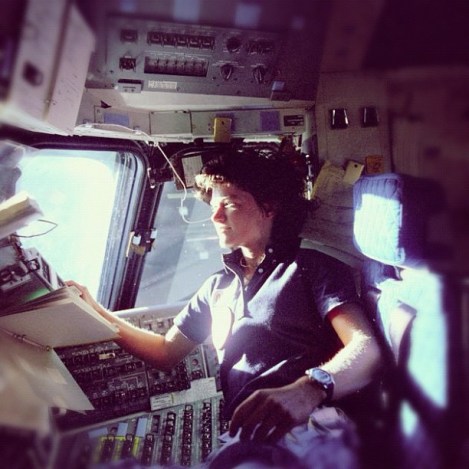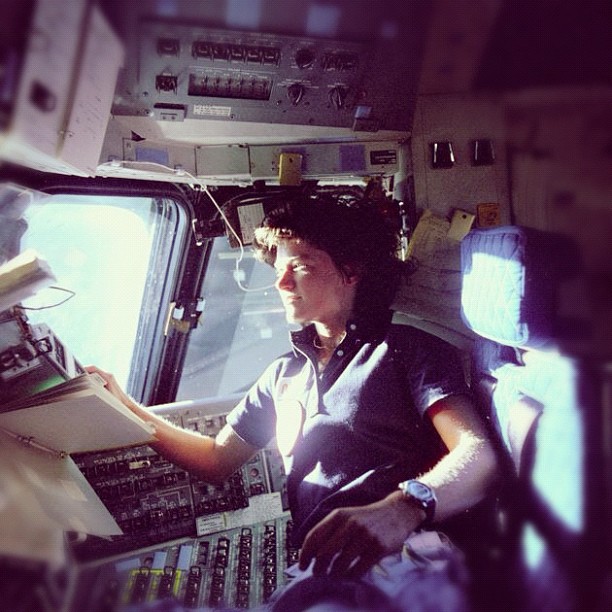Those of us who grew up in the Space Shuttle era remember watching tiny, scratchy televisions on various mornings, at home or in school; remember the adrenaline of seeing that odd craft sitting on the launchpad. That visual is the one that sticks because it’s the one we watched the most. A shuttle launch for us was all about the promise, the build-up. It’s coming, it’s coming. Five minutes. One minute. 30 seconds. You have X amount of time before something spectacular happens.

Sally Ride on the flight deck of Challenger. (Photo by NASA.)
Sally Ride lived a life of inspiration, engagement, exhortation. Her first trip into space was an accomplishment that lasted beyond that initial spark of the engines, a rare flight for which the anticipation of the launch was only a precursor to what we would learn and experience and appreciate. She was not only the first American woman to hover above the atmosphere, but she was a brilliant, savvy, compelling woman whom everyone, even a kid like me, understood was exceptional.
Ride’s commitment, first and foremost, was to broadening understanding. After her time with NASA, she formed Sally Ride Science, with the goal of getting students engaged in and excited about science. (Who better to do it? What kid is going to look Dr. Sally Ride in the eye and say, “Nah, not interested”?) Three years ago, that push to inform resulted in a book — co-written with Tam O’Shaughnessy, the woman we now know to be her partner. Titled Mission: Planet Earth, the book is an outline of how and why the climate is changing. The publisher provides an excerpt:
[From space,] I could see how fragile Earth is. When I looked toward the horizon, I could see a thin, fuzzy blue line outlining the planet. At first, I didn’t know what I was seeing. Then I realized it was Earth’s atmosphere. It looked so thin and so fragile, like a strong gust of interplanetary wind could blow it all away. And I realized that this air is our planet’s spacesuit — it’s all that separates every bird, fish, and person on Earth from the blackness of space. …
To a person standing on the ground, our air seems to go on forever. The sky looks so big, and people haven’t worried about what they put into the air. From space, though, it’s obvious how little air there really is. Nothing vanishes “into thin air.” The gases that we’re sending into the air are piling up in our atmosphere. And that’s changing Earth’s life-support system in ways that could change our planet forever.
In its obituary, the New York Times notes another time when Ride embraced truth and understanding — in the aftermath of the Challenger crash in 1986.
As a member of the panel appointed by President Ronald Reagan to investigate the accident, Ms. Ride gained a reputation for asking tough questions. The panel learned from testimony and other evidence that there had been signs of trouble on earlier Challenger flights, but that they had been dismissed as not critical. Dr. Ride told a colleague it was difficult not to be angered by the findings.
One witness was Roger Boisjoly, an engineer who had worked for the company that made the shuttle’s rocket boosters and who had been shunned by colleagues for revealing that he had warned his bosses and NASA that the boosters’ seals, called O-rings, could fail in cold weather. The Challenger had taken off on a cold morning.
After his testimony, Dr. Ride, who was known to be reserved and reticent, publicly hugged him. She was the only panelist to offer him support. Mr. Boisjoly, who died in February, said her gesture had helped sustain him during a troubled time.
That this embrace was included in the retelling of an exceptional woman’s life, this one, cosmically brief touch, makes its message impossible to ignore. Telling the truth even in the face of disaster, a willingness to stand up to power and argue for evidence and accuracy — these are the hallmarks of science and discovery.
For those of us watching at home, the imminent launch of the shuttle and then that shaky, squawking roar that came from the little speaker in our TV sets was the culmination of our excitement. For Ride and for other scientists, it was the impatient and too-long start to the real thing: the experiments and experience that informed the rest of humanity about the world in which we live.



